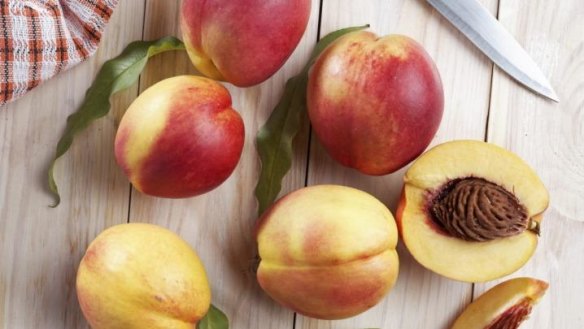How to grow nectarines in Canberra - gardening tips

We have just sat down at morning tea to eat our first golden nectarine as I write this article. The skin was a rich red and the flesh was just divine. It is the most favourite fruit of my wife Noreen. Nectarines ripened on the tree then picked ready for eating will be full of juice and have a wonderful flavour.
That is enough incentive to keep trying to grow this temperamental fruit in the Canberra region. Well, not quite temperamental because not a lot can go wrong, just that we are on the edge of the good growing regions because of our very cold winters. The high likelihood of heavy frosts in late August and early September is the greatest determinant of the harvest some six months later.
But if you want to be a "risk taker" then I would highly recommend planting one or two nectarine trees (and a couple of peach trees to partner them). Nectarine trees do need 600-800 chill hours over winter to help with good bud setting. Canberra can provide that level of winter chill. These trees are fast growers and they will produce fruit on last season's growth. So in two or three years after planting you can hope for a good harvest. In fact, some years you may have to thin off more than half of the set fruit, if the spring goes well for you. Be brave in October or early November when you are faced with 60-80 little nectarines along each main branch. If you do not thin out to leave just one or two each hand length, you will end up with just bucket loads of tiny fruit at harvest time.

During the growing season provide the trees, around their drip line, with a good sprinkling of organic fertiliser. Mulch well under each tree and keep them well watered over the weeks of summer. The trees produce well when they have a good supply of moisture and they are not competing with weeds for nutrients.
Nectarine and peach trees need to be pruned back hard each winter. You can complete pruning in May if you wish to, following the fall of all the leaves. Remove some of the little lateral sprig branches and keep the height of the tree down to a manageable 2.5-3.0 metres. And as the tree ages, allow some new, low branches to grow up, so that you can renew the tree every five or six years. Otherwise, you can end up with a very tall, straggly tree producing only a small crop.
If there is any mummified fruit, remove and dispose at the time of pruning. Nectarine (and its cousin the peach) are susceptible to two disease problems and orchard hygiene is important. Brown rot is past on very easily by leaving the mummified fruit hanging on the tree over winter. The other problem affects the leaves, namely the fungus that causes leaf curl. Apply a pre bud burst preventative spray of the copper sulphate spray (premixed and sold as Kocide). If you are too slow to apply the spray in early spring, then the leaves become very infected and curl up and you can do nothing to help the cause. You will then have to wait for them to wither and dry up. They should then be removed and disposed of. The tree will produce a second crop of leaves, which normally will be free of any leaf curl.
There are now quite a range of nectarine varieties available. I have had most success with Red Gold and May Grand with their large, golden fleshed fruits. Goldmine is a good, old Australian white fleshed variety and Arctic Sweet is another good juicy, white flesh nectarine with bright red skin. Fairlane is a late maturing, yellow fleshed variety with very good flavour.
This week in the garden
- Plant out loose leaf lettuces, rocket and beetroot to produce a quick mixed salad leaf supply
- Begin planting out your winter vegetable seedlings into a garden bed with plenty of compost dug in.
- Leave plenty of space between each seedling as they can all grow to between 30 and 40 cm in width.
- Plant a new planter box with basil and of coriander to provide for your late summer days.
- With apples, keep checking the crop and remove any apples that have been spiked with the codling moth, so the remaining fruit has a much better chance of staying clean.
- After the recent rains, tomatoes, capsicums and eggplant bushes will grow vigorously so keep them well staked and tied up.
Nectarine and berry pie
Ingredients
6 large nectarines
125g raspberries
125g blueberries
2 tsp lemon juice
1 tsp lemon rind
3 tbsp cornflour
¼ cup sugar
¼ tsp nutmeg
Sweet pastry
2½ cups plain flour
⅔ cup icing sugar
150g butter
cold water
Method
Preheat the oven to 220C. Prepare and then roll out the pastry, to fit a 23cm pie plate.
For the pastry: sift the flour and then combine with the icing sugar. Rub in the butter with your thumbs and forefingers until the mixture resembles breadcrumbs. Add a little water, cutting it into the mixture with a flat bladed knife. Keep adding a little more water until you have rough dough. Knead with your hands gently to make the dough smooth. Place in the refrigerator for 30 minutes. Then roll out the pastry to completely fill the pie plate and have ample lengths hanging over the sides of the plate.
Slice up the nectarines and mix them with the raspberries and blueberries. Add in the lemon juice, lemon rind, sugar and nutmeg and mix well. Mix the cornflour in a small amount of water until it is a smooth paste then add to the fruit mixture.
Arrange the fruit mixture in the centre of the pastry. Fold inwards the edges of the pastry over the fruit, towards the centre of the pie, overlapping as you go. Bake the pie for 23-40 minutes until the pastry is golden and the fruit is well cooked and tender.
Owen Pidgeon runs the Loriendale Organic Orchard near Hall.
Restaurant reviews, news and the hottest openings served to your inbox.
Sign up